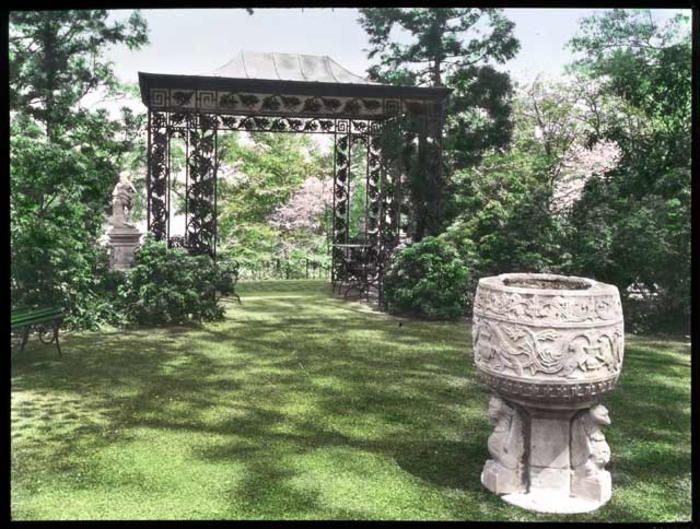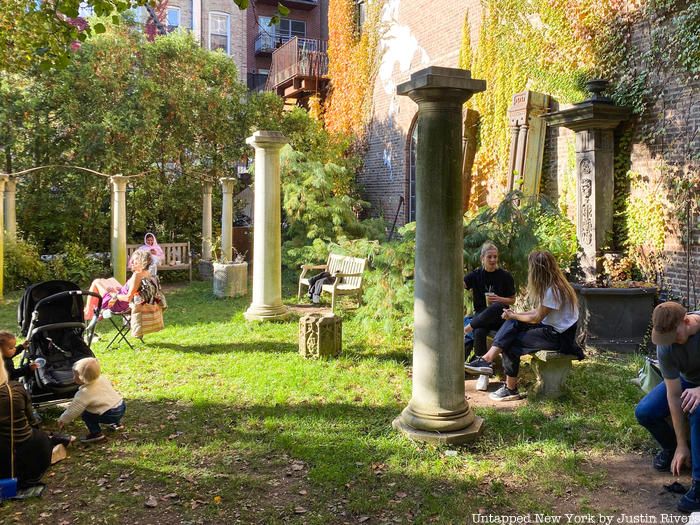Last-Minute NYC Holiday Gift Guide 🎁
We’ve created a holiday gift guide with presents for the intrepid New Yorker that should arrive just in time—


The Elizabeth Street Garden in Manhattan’s Little Italy is a community garden filled with an eclectic assemblage of statuary. The sculptures and various pieces of architectural salvage were curated by gallery owner Allan Reiver. In 1991, Reiver leased the vacant lot on which the garden now sits and started to transform it into the lush community space you see today. In addition to planting trees and laying pathways, he filled the garden with unique pieces salvaged from across the country, many hailing from opulent gilded age estates. One of the first pieces Reiver placed in the garden, an ornate iron gazebo, has ties to America’s greatest landscape architect, Frederick Law Olmsted.

From Delaware Park in Buffalo, New York, to the grounds of the Biltmore Estate in Asheville, North Carolina, Olmsted left his mark on public and private landscapes throughout the nation, though he is most well-known for his design of New York City’s Central Park. After Olmsted died in 1903, his sons John and Frederick Jr. kept the family business going under the name of Olmsted Brothers. One of the first commissions the brothers took on was adding gardens to the Burrwood Estate in Cold Spring Harbor, Long Island. Burrwood was the Gilded Age estate of Walter Jennings, a director and secretary of the Standard Oil Company. The estate buildings, constructed in 1898, were designed by Carrere & Hastings, the same duo who designed the Standard Oil Building, the Cunard Building, and the main branch of the New York Public Library. After Jennings and his wife died, the estate went to their son. In 1951, the estate was sold to the Industrial Home for the Blind. The institute occupied the building until its demolition in 1993.
According to the AIA Guide to Nassau and Suffolk County 1992, the estate is named after Aaron Burr, an ancestor of Jennings. The design of the five-story, brick and marble-trimmed Georgian mansion was inspired by Jennings’ travels in England and the manorhouses he saw there. The fifty rooms inside the home were decorated with extravagant details such as Tiffany windows, “imported marble mantels, decorative wood-paneling and painted wall panels depicting the Eight Wonders of the World.”

The Gazebo at Burrwood, Image via The Smithsonian Institution
The magnificent grounds of the estate stretched out over 400-acres and boasted views of the Long Island Sound. The acreage included farmland and formal gardens designed by Frederick Law Olmsted‘s sons, the Olmsted Brothers. Mrs. Jennings was horticulturists and enjoyed sharing her bountiful gardens with the public. She frequently hosted flower shows and offered her garden as a venue for functions thrown by organizations like the Nassau County Horticultural Society. In addition to the beautiful flowers, the gardens featured various statues, fountains, stone walls, and amazing views of the sound. One of the structures the Olmsted Brothers designed for the grounds was a large iron gazebo. That piece now sits in the Elizabeth Street Garden. The gazebo sat amongst trees and bushes and in front of a grassy clearing at the estate, framing two sculptures on either side.
“This is the centerpiece for many, many events we have here,” Joseph Reiver mentioned on our recent tour of the Elizabeth Street Garden for Untapped New York Insiders, “A lot of people like to get married under the gazebo.” The revenue generated from private events like weddings goes to support the garden. The gazebo was one of the first items placed by Joseph’s father Allan in the early days of laying out the shape of the Elizabeth Street Garden. It offers visitors a shady spot to rest and is near a pair of marble columns that were also salvaged from the Burrwood estate. One New York Times article refers to the gazebo as a replica, though documents from the garden refer to it as the real thing.

Since 2013, the garden has been run by volunteers in the community under the management of the 501(c)(3) not-for-profit organization Elizabeth Street Garden (ESG). The future of the garden is currently threatened by a proposal to build affordable housing on the site. The non-profit which manages the garden is currently in a legal battle to maintain the space. You can stay up to date on proceedings, find out how you can get involved, and donate to the garden’s legal fund here! The garden is open to the public year-round. Current hours are noon to 4 p.m. Wednesday through Friday and 10 a.m. to 4 p.m. on Saturday and Sunday.
Next, check out 10 of the Best Secluded Gardens in Manhattan and 11 Unique Community Gardens in NYC’s East Village
Subscribe to our newsletter